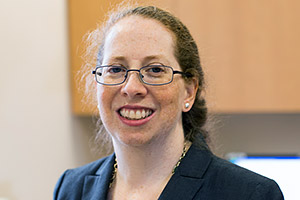

Exemplary Leadership
Communicating to Stop the Spread of Communicable Disease
This past year, Dr. Belinda Ostrowsky frequently found herself where she doesn’t like to be—in the spotlight.

Belinda Ostrowsky, M.D.In November 2016, in the grand ballroom at Montefiore’s Tishman Learning Center, Dr. Steven Safyer, Montefiore’s president and CEO, presented Dr. Ostrowsky with the President's Award—the highest recognition given to a Montefiore associate, and a testament to her collaborative, self-effacing leadership style. It followed an honor received in June; the department of medicine presented her with its Citizenship Award, which is given to an individual who demonstrates teamwork and a collaborative approach for co-workers and colleagues.
“People like Belinda are not likely to sing their own praises, but they do so many things throughout the day, big and small to make everything work,” said Dr. Liise-anne Pirofski, chief of the division of infectious diseases at Einstein and Montefiore, who nominated Dr. Ostrowsky for the President's Award. “Belinda is an example of a new generation of leader, who has mastered the art and understands the importance of interdisciplinary collaboration and bridge-building.”
“When I’m doing my job right the spotlight isn’t on me, because I’ve been able to prevent things from going wrong and help protect our patients,” said Dr. Ostrowsky, who joined the Einstein faculty and Montefiore staff in 2008 to develop and lead an innovative multi-campus Antibiotic Stewardship Program (ASP), and was promoted in March 2016 to healthcare epidemiologist for Montefiore Health System.
The Great Unknown
In her role as director of epidemiology, antimicrobial stewardship, & infection prevention, Dr. Ostrowsky is responsible for tracking, prevention, treatment and control of infections for Montefiore’s inpatient and ambulatory care operations throughout the Bronx.
“My job isn’t to count the number of infections within our facilities, but to have fewer of them to count,” she explained.
“I want to create a proactive strategy, with structure and resources in place to pull out in an emergency,” she added. These include strategies to collect and share surveillance to help clinical staff recognize problems early; templates to communicate information that evolve as events unfold; and multidisciplinary relationships throughout the medical center so additional personnel resources with complementary skills can be mobilized for extraordinary challenges.
One such challenge was the October 2014 Ebola outbreak. A Liberian man returning to Texas from a trip to Africa died from the disease, and two nurses who had cared for him tested positive for the virus. Later that month New York City physician Craig Spencer, who had been in Guinea treating Ebola patients, also tested positive.
“Nobody knew what was going to happen,” Dr. Pirofski recalled. “Belinda led Montefiore's response to the Ebola epidemic rationally, with a sense of calm that brought comfort and understanding during a complex and uncertain time.”
Working with hospital administrators and several departments, as well as with local and national public health departments, Dr. Ostrowsky created protocols to evaluate travelers from affected countries, and prepared for the possibility that Montefiore would be treating patients in a specialized treatment unit.
“A lot of resources and effort and groups had to be redirected. It’s very difficult to ask people to redirect their energies, to add on to their day, to learn new protocols and ways of doing things,” said Dr. Pirofski, who was among those struck by Dr. Ostrowsky’s “complete sense of calm, rising above the storm.”
We Are the Champions
Ebola, Zika, Legionella and other exotic infections are not Dr. Ostrowsky’s biggest headache. Every year, she contends with preventing the spread of healthcare-associated infections and influenza with “simple, basic” strategies, such as encouraging patients and doctors to get vaccinated, promoting hand-washing, ensuring staff doesn’t come to work sick, and other measures such as recognizing and isolating affected patients efficiently.
“I really like to teach, and what I do is all about helping guide people to prevent infection and overprescribing,” said Dr. Ostrowsky. She develops workshops and educational materials for employees, residents and medical students, and she recruits “champions” to amplify her efforts.
To Dr. Ostrowsky, a “champion” is a healthcare worker who emulates behaviors and processes she wants the staff to adopt, and who can persuade co-workers to adopt them too. To her, these can include a chief resident who talks to other residents about prescribing antibiotics responsibly; a nurse on the floor who models infection prevention behaviors; or a member of the housekeeping staff who recognizes that he or she isn’t just cleaning rooms, but is on the front line in preventing infection.
“We need champions at all levels in any of our preventative initiatives,” she said.
“Belinda helps people understand there’s a rhyme and reason for doing things a new or different way, this is so crucial in driving change,” observed Dr. Pirofski.
“I can’t be out there preventing all infections or overprescribing, so I collaborate with people to hear different opinions and ideas, and engage clinical champions at the front lines of the challenge,” said Dr. Ostrowsky. “I want to empower our staff so that they are all an important part of the solution and part of the team to prevent infection and antibiotic resistance.”
Posted on: Friday, February 17, 2017

Tablet Blog